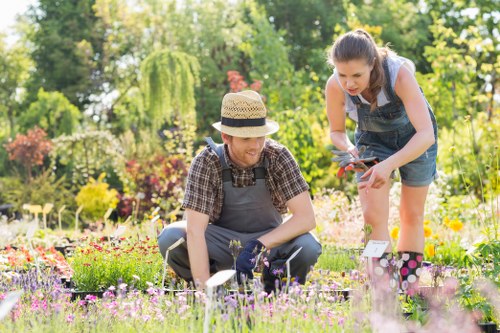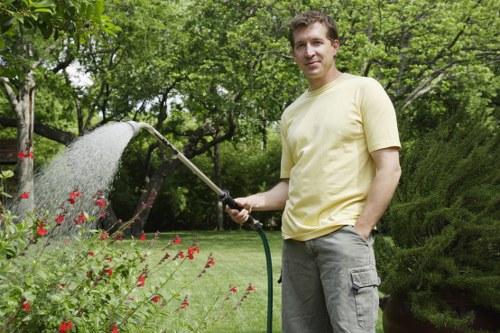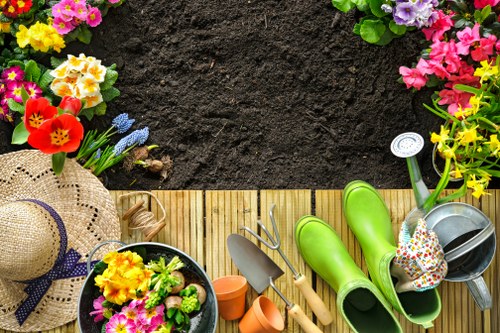Landscaping in Gunnersbury: Transform Your Outdoor Space

Welcome to the vibrant world of landscaping in Gunnersbury, where your outdoor dreams can become reality. Whether you’re looking to create a serene garden retreat, a functional outdoor kitchen, or a lush green space for your family to enjoy, Gunnersbury offers a range of possibilities to enhance your property’s aesthetic and value.
Gunnersbury, located in the heart of London, is renowned for its green spaces and picturesque neighborhoods. This makes it an ideal location for homeowners seeking to invest in professional landscaping services. With the right expertise, you can turn your garden into a stunning extension of your home, tailored to your personal style and needs.
In this comprehensive guide, we’ll explore the various aspects of landscaping in Gunnersbury, from design concepts and plant selection to sustainable practices and maintenance tips. Whether you’re embarking on a complete garden overhaul or simply looking to refresh your existing space, this article will provide you with the insights and inspiration you need.

Why Choose Professional Landscaping in Gunnersbury?
Investing in professional landscaping services in Gunnersbury offers numerous benefits that go beyond mere aesthetics. Here are some compelling reasons to consider hiring experts for your outdoor projects:
- Expertise and Experience: Professional landscapers possess the knowledge and skills to design and implement projects that are both beautiful and functional.
- Increased Property Value: A well-designed garden can significantly enhance your property’s market value, making it a smart investment.
- Time and Effort: Landscaping can be time-consuming and labor-intensive. Professionals handle all aspects, allowing you to enjoy the results without the hassle.
- Access to Quality Materials: Landscapers have access to a wide range of plants, materials, and equipment that may not be readily available to homeowners.
Moreover, local landscapers in Gunnersbury are familiar with the area's climate, soil conditions, and plant varieties, ensuring that your garden thrives year-round.

Designing Your Ideal Landscape
Understanding Your Needs and Preferences
The first step in creating a stunning landscape is understanding your own needs and preferences. Consider how you intend to use your outdoor space:
- Relaxation: Do you want a peaceful garden for unwinding after a long day?
- Entertainment: Are you planning to host gatherings and need spaces for dining and socializing?
- Play Areas: Do you have children who need a safe and fun area to play?
By clearly defining your objectives, you can work with a landscaper to develop a design that caters to your specific requirements.
Choosing a Design Style
There are various design styles to consider when landscaping in Gunnersbury. Some popular options include:
- Modern: Clean lines, minimalist features, and contemporary materials.
- Traditional: Classic plants, symmetrical layouts, and timeless elements.
- Japanese: Zen-inspired gardens with water features, rocks, and carefully pruned plants.
- English Cottage: A charming, relaxed style with a mix of colorful flowers and greenery.
Choosing a style that resonates with you will ensure that your garden reflects your personality and complements your home’s architecture.

Selecting the Right Plants for Gunnersbury
Climate and Soil Considerations
Gunnersbury experiences a temperate climate, which influences the types of plants that will thrive in your garden. It’s essential to select plants that are well-suited to the local conditions:
- Hardiness: Choose plants that can withstand the temperature fluctuations typical of the area.
- Soil Type: Assess your garden’s soil and select plants that will grow well in its specific composition.
- Sunlight Exposure: Determine how much sunlight different areas of your garden receive and select plants accordingly.
Consulting with a local landscaper can help you identify the best plant varieties for your specific garden conditions.
Top Plant Choices for Gunnersbury Gardens
Here are some popular plant selections that thrive in Gunnersbury’s environment:
- Roses: Classic and versatile, roses add color and fragrance to any garden.
- Lavender: Known for its soothing scent and attractive blooms, lavender is perfect for adding a touch of elegance.
- Hostas: Ideal for shaded areas, hostas provide lush foliage and delicate flowers.
- Boxwood: Excellent for creating structured hedges and borders.
- Hydrangeas: These flowering shrubs offer vibrant blooms and are relatively low-maintenance.
Incorporating a mix of these plants can create a diverse and resilient garden.

Hardscaping Elements in Gunnersbury Landscapes
Paths and Patios
Hardscaping features like paths and patios play a crucial role in defining the functionality and flow of your garden:
- Materials: Choose from materials such as natural stone, brick, or concrete to match your design style.
- Design: Curved paths can create a natural, flowing feel, while straight lines offer a more formal appearance.
- Functionality: Ensure that paths and patios are strategically placed for easy access to different garden areas.
Properly designed hardscaping enhances both the beauty and usability of your outdoor space.
Water Features
Incorporating water features like fountains, ponds, or waterfalls can add a sense of tranquility to your garden:
- Aesthetic Appeal: Water features serve as focal points, drawing attention and adding visual interest.
- Sound: The sound of flowing water creates a calming atmosphere, perfect for relaxation.
- Wildlife: Water features can attract birds and other wildlife, enriching your garden’s ecosystem.
When designing water features, consider their placement and maintenance requirements to ensure they complement your overall landscape.
Eco-Friendly Landscaping Practices
Adopting sustainable practices in your landscaping efforts not only benefits the environment but also ensures a healthier and more resilient garden:
- Water Conservation: Implementing efficient irrigation systems and selecting drought-tolerant plants can significantly reduce water usage.
- Organic Gardening: Using organic fertilizers and pest control methods promotes a natural and chemical-free garden.
- Composting: Recycling garden waste into compost enriches the soil and reduces landfill contributions.
- Native Plants: Incorporating native species supports local biodiversity and requires less maintenance.
By integrating these eco-friendly practices, you create a sustainable landscape that thrives with minimal environmental impact.
Rain Gardens
Rain gardens are designed to capture and absorb rainwater, reducing runoff and preventing water pollution:
- Location: Place rain gardens in areas where water collects naturally, such as near downspouts or low-lying sections of your garden.
- Plant Selection: Choose plants that can tolerate both wet and dry conditions to ensure the garden’s effectiveness.
- Aesthetic Integration: Design rain gardens to blend seamlessly with your existing landscape, enhancing both functionality and beauty.
Maintaining Your Gunnersbury Garden
Proper maintenance is essential to keep your landscaped garden looking its best year-round. Here are some key maintenance tasks to consider:
- Pruning and Trimming: Regularly prune shrubs and trees to promote healthy growth and maintain desired shapes.
- Weeding: Keep your garden free from invasive weeds that can compete with your plants for resources.
- Mulching: Apply mulch to retain soil moisture, suppress weeds, and regulate soil temperature.
- Fertilizing: Provide essential nutrients to your plants through appropriate fertilization schedules.
- Pest Control: Monitor for pests and diseases, addressing issues promptly to prevent widespread damage.
Seasonal Care
Different seasons require specific care to ensure your garden remains healthy and attractive:
- Spring: Prepare for the growing season by planting new flowers, pruning, and cleaning up garden debris.
- Summer: Focus on watering, weeding, and managing pests to keep your garden thriving in the heat.
- Autumn: Rake fallen leaves, plant bulbs for next year, and protect plants from early frosts.
- Winter: Prepare your garden for cold weather by covering delicate plants and planning for the upcoming year.
Consistent maintenance ensures that your garden remains a beautiful and inviting space throughout the year.
Choosing the Right Landscaping Services in Gunnersbury
Selecting a reputable landscaping service is crucial for achieving the desired results. Here are some tips to help you make an informed decision:
- Research and Reviews: Look for companies with positive reviews and a strong reputation in the Gunnersbury area.
- Portfolio: Review the company’s previous projects to ensure their style aligns with your vision.
- Credentials: Verify that the landscaper is licensed, insured, and has the necessary certifications.
- Consultations: Schedule consultations to discuss your project and assess the landscaper’s understanding of your needs.
- Quotes and Contracts: Obtain detailed quotes and ensure all terms are clearly outlined in the contract before commencing work.
Local Expertise
Hiring a local landscaper ensures they are familiar with Gunnersbury’s specific conditions, including climate, soil types, and native plant species. This expertise translates to a more successful and sustainable garden design.
Customized Services
Choose a landscaping service that offers personalized solutions tailored to your unique requirements. From initial design to installation and ongoing maintenance, a customized approach ensures your garden meets your expectations.
Budgeting for Your Landscaping Project
Establishing a clear budget is essential for the successful completion of your landscaping project. Here are some factors to consider when budgeting:
- Design and Planning: Costs associated with designing your landscape, including consultations and blueprints.
- Materials: Expenses for plants, soil, mulch, hardscaping materials, and other supplies.
- Labor: Fees for the landscaper’s time and expertise during installation and maintenance.
- Permits: Any necessary permits or approvals required for significant landscaping changes.
- Contingency: Allocate a portion of your budget for unexpected expenses or changes in the project scope.
Cost-Saving Tips
To manage costs effectively, consider the following tips:
- Prioritize: Identify the most important elements of your landscape and allocate funds accordingly.
- Phased Implementation: Break the project into phases to spread out expenses over time.
- DIY Elements: Handle simpler tasks like planting or mulching yourself to reduce labor costs.
- Shop Smart: Purchase materials during sales or off-season periods to take advantage of lower prices.
Value vs. Cost
While it’s important to stay within budget, prioritize quality and value over the cheapest options. Investing in durable materials and professional services can save you money in the long run by reducing the need for frequent repairs or replacements.
Innovative Landscaping Trends in Gunnersbury
Staying up-to-date with the latest landscaping trends can enhance the appeal and functionality of your garden. Here are some current trends gaining popularity in Gunnersbury:
- Vertical Gardens: Maximizing space with vertical planting systems, perfect for small gardens or urban settings.
- Smart Irrigation: Utilizing smart technology to automate and optimize watering schedules, promoting water conservation.
- Outdoor Living Spaces: Creating comfortable and stylish areas for dining, lounging, and entertainment.
- Edible Gardens: Integrating vegetables, herbs, and fruit trees into your landscape for a functional and sustainable garden.
- Native and Drought-Tolerant Plants: Focusing on plants that require minimal water and maintenance, supporting local ecosystems.
Lighting and Ambiance
Incorporating lighting elements into your landscape design can extend the usability of your garden into the evening hours and create a captivating ambiance:
- Solar Lights: Eco-friendly lighting options that reduce energy consumption.
- Pathway Lighting: Enhances safety and highlights the beauty of garden paths.
- Accent Lighting: Focuses on specific garden features, such as water elements or sculptures, to create visual interest.
Sustainable Materials
Using sustainable materials in your landscaping projects supports environmental conservation and adds a natural aesthetic to your garden:
- Recycled Materials: Incorporate recycled stone, wood, or metal into hardscaping features.
- Permeable Pavers: Allow rainwater to seep through, reducing runoff and promoting groundwater recharge.
- Organic Mulches: Use natural mulches like bark or compost to enrich the soil and suppress weeds.
Enhancing Privacy and Security
Creating a sense of privacy and security can make your garden a more comfortable and safe space:
- Hedges and Fences: Planting tall hedges or installing fences can create natural barriers and restrict visibility.
- Privacy Screens: Use trellises or lattice panels combined with climbing plants to achieve both privacy and visual appeal.
- Lighting: Strategically placed lighting can deter intruders and enhance safety during nighttime.
- Gated Entrances: Installing gates adds an extra layer of security while defining the boundaries of your garden.
Sound Barriers
In addition to visual privacy, sound barriers can help create a peaceful environment by reducing noise pollution:
- Fencing: Solid fences absorb sound, making them effective noise barriers.
- Plant Barriers: Dense vegetation can help muffle external sounds, contributing to a quieter garden space.
- Water Features: The sound of flowing water can mask unwanted noise, adding tranquility to your garden.
Secure Storage
Providing secure storage solutions for garden tools and equipment keeps your outdoor space organized and safe:
- Sheds: Install a sturdy shed to store tools, gardening supplies, and outdoor furniture.
- Cabinets and Lockers: Utilize weather-resistant cabinets or lockers for smaller items.
- Hidden Storage: Incorporate discreet storage options within your landscape design to maintain aesthetics.
Integrating Technology into Your Landscape
Modern technology can significantly enhance the functionality and enjoyment of your garden:
- Smart Irrigation Systems: Automate watering schedules based on weather conditions, ensuring optimal plant health.
- Outdoor Audio Systems: Enjoy your favorite music or nature sounds while spending time in your garden.
- Climate Control: Implement features like misting systems or shade structures to maintain comfortable temperatures.
- Security Cameras: Enhance the security of your garden with strategically placed cameras.
Lighting Automation
Automated lighting systems allow you to control garden lights remotely, adding convenience and enhancing security:
- Timers: Set lights to turn on and off at specific times, reducing the need for manual operation.
- Motion Sensors: Lights can activate when movement is detected, providing illumination when needed.
- Smart Controls: Use smartphone apps or voice commands to manage your garden lighting seamlessly.
Energy Efficiency
Incorporating energy-efficient technologies into your landscape reduces your environmental footprint:
- Solar-Powered Features: Utilize solar energy for lighting, water pumps, and other garden elements.
- LED Lighting: Install LED lights for lower energy consumption and longer lifespan compared to traditional bulbs.
- Energy-Efficient Appliances: Choose eco-friendly outdoor appliances and equipment to minimize energy use.
Personalizing Your Garden
Your garden should reflect your personal style and interests. Here are some ideas to add a unique touch to your landscape:
- Art and Sculptures: Incorporate artistic elements to create focal points and add character.
- Custom Seating Areas: Design comfortable and stylish seating arrangements that encourage relaxation and socializing.
- Themed Gardens: Create sections of your garden based on specific themes, such as a herb garden, butterfly garden, or rock garden.
- Unique Plant Combinations: Experiment with different plant varieties and arrangements to achieve a distinctive look.
Outdoor Furniture and Accessories
Choosing the right furniture and accessories can enhance the functionality and beauty of your garden:
- Seating: Invest in comfortable chairs, benches, or hammocks for lounging and enjoying your garden.
- Dining Areas: Set up an outdoor dining table and chairs for alfresco meals and entertaining guests.
- Decorative Elements: Add items like garden statues, wind chimes, and decorative pots to personalize your space.
- Shade Structures: Install pergolas, canopies, or umbrellas to provide shade and create comfortable outdoor areas.
Color Schemes
Selecting a cohesive color palette can unify your garden’s design:
- Monochromatic: Use varying shades of a single color for a harmonious and elegant look.
- Complementary Colors: Pair colors opposite each other on the color wheel for vibrant and dynamic combinations.
- Analogous Colors: Choose colors next to each other on the color wheel for a serene and cohesive appearance.
Seasonal Planting Strategies
To maintain a lively and colorful garden throughout the year, implement seasonal planting strategies:
- Spring: Plant bulbs like tulips and daffodils, and incorporate early-blooming annuals.
- Summer: Focus on heat-tolerant plants, vibrant flowers, and maintain regular watering schedules.
- Autumn: Add fall-blooming perennials, hardy shrubs, and prepare plants for winter.
- Winter: Use evergreen plants, ornamental grasses, and winter-flowering species to maintain structure and interest.
Continuous Blooming
Plan your plantings to ensure a continuous display of blooms throughout the seasons:
- Early Spring: Snowdrops and crocuses.
- Late Spring: Peonies and irises.
- Summer: Roses and hydrangeas.
- Autumn: Chrysanthemums and asters.
- Winter: Hellebores and winter heathers.
Plant Maintenance
Regular maintenance tasks help keep your garden healthy and vibrant year-round:
- Deadheading: Remove spent flowers to encourage new blooms and maintain plant health.
- Staking: Support tall or heavy plants to prevent damage from wind and weather.
- Mulching: Refresh mulch layers to retain moisture and suppress weeds.
Maximizing Small Garden Spaces
If you have a limited outdoor area, effective landscaping can maximize your space's potential:
- Vertical Gardening: Utilize walls, fences, and trellises to grow plants vertically, saving ground space.
- Compact Plant Varieties: Choose dwarf or compact plant species that take up less space.
- Multi-Functional Features: Incorporate elements that serve multiple purposes, such as seating with built-in planters.
- Mirrors and Reflective Surfaces: Use mirrors or water features to create the illusion of a larger space.
Smart Layouts
Plan your garden layout to ensure efficient use of space:
- Zoning: Divide your garden into functional zones, such as dining, lounging, and planting areas.
- Pathways: Design narrow or meandering pathways to guide movement without occupying excess space.
- Storage Solutions: Incorporate concealed storage to keep tools and equipment out of sight.
Creative Planting Techniques
Employ creative planting techniques to enhance the appearance and functionality of small gardens:
- Container Gardening: Use pots, planters, and raised beds to grow plants and create visual interest.
- Layered Planting: Arrange plants in layers, with taller species at the back and shorter ones in front, to maximize space and create depth.
- Hanging Plants: Suspend plants from hooks or hanging baskets to free up ground space.
Conclusion: Create Your Dream Garden in Gunnersbury
Embarking on a landscaping project in Gunnersbury is an exciting opportunity to transform your outdoor space into a personalized haven. By considering design principles, selecting appropriate plants, integrating sustainable practices, and partnering with experienced professionals, you can create a garden that not only enhances your home’s beauty but also offers a peaceful retreat for relaxation and enjoyment.
Remember to plan carefully, stay informed about the latest trends, and maintain your garden with regular care to ensure its longevity and vibrancy. Whether you’re starting from scratch or looking to revamp your existing garden, the possibilities in Gunnersbury are endless.
Ready to bring your landscaping vision to life? Contact us today to schedule a consultation and take the first step toward creating your dream garden in Gunnersbury.
Book your service now and transform your outdoor space into a stunning masterpiece that reflects your unique style and enhances your lifestyle.